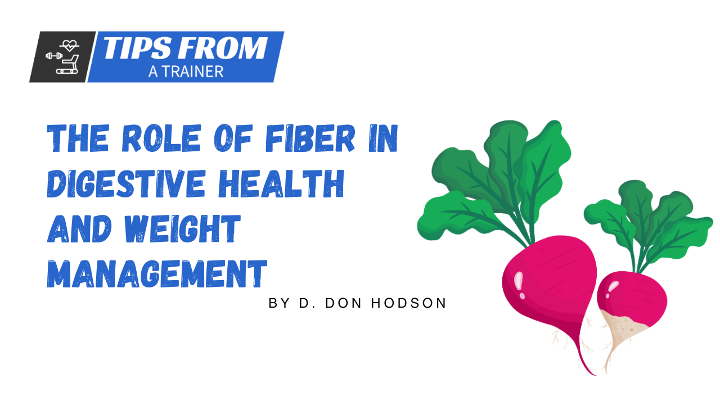Introduction
Effective digestion is at the core of our well-being, influencing everything from nutrient absorption to energy levels and immune function. Similarly, maintaining a healthy weight is a crucial pillar of overall health, guarding against chronic ailments and promoting vitality.
Enter fiber, a remarkable plant-based carbohydrate. It's the unsung hero behind a well-functioning digestive system and a key player in weight management. Picture fiber as nature's broom, gently sweeping through your intestines and ensuring regular bowel movements. Not stopping there, fiber nurtures your gut, reducing the risk of digestive disorders and maintaining its optimal balance.
But fiber's role doesn't end within your digestive tract. It's a master of satiety, sending signals of fullness to your brain and aiding weight loss efforts. Think of it as your partner in portion control. By delving into this article, you'll embark on a journey to unravel the dual power of fiber in digestive health and weight management.
As we delve deeper, you'll uncover different types of fiber found in a variety of plant-based foods. These nutritional allies provide a wealth of benefits, from fostering regularity to supporting a well-balanced gut ecosystem. Together, we'll explore practical tips on seamlessly integrating fiber into your daily meals, ensuring a harmonious relationship between your health goals and your taste buds.
Beyond the theoretical, this article is your guide to real-world implementation. Discover recommended daily fiber intake, a navigational beacon on your quest for equilibrium. And don't worry, we won't leave you unprepared. Overcoming potential challenges is part of the journey, and we'll provide you with actionable strategies to conquer them.
Join us as we demystify the world of fiber, unlocking its potential to transform your digestive health and empower your weight management goals. In partnership with this unassuming nutrient, you'll embark on a path toward vitality and well-being, fueled by the natural power of fiber-rich foods.
Table of Contents
Introduction
Understanding Fiber
Definition and types of dietary fiber
Sources of fiber in the diet
Recommended daily intake of fiber for adults
Digestive Health Benefits of Fiber
Promotion of regular bowel movements and prevention of constipation
Improved gut health through the support of beneficial gut bacteria
Prevention of gastrointestinal disorders, such as diverticulosis and hemorrhoids
Potential role in reducing the risk of colorectal cancer
Weight Management Benefits of Fiber
Increased satiety and reduced appetite, leading to lower calorie intake
Slowed digestion and absorption of nutrients, promoting stable blood sugar levels
Enhanced weight loss efforts by reducing overall energy density of the diet
Maintenance of a healthy body weight and prevention of weight regain
Strategies for Increasing Fiber Intake
Choose whole foods over processed options
Gradually increase fiber intake
Include a variety of fiber-rich foods in your diet
Read food labels and choose high-fiber options
Overcoming Challenges and Precautions
Increase fiber intake gradually to avoid digestive discomfort
Drink plenty of water
Consider individual tolerances and medical conditions
Adjust fiber intake based on personal needs
Incorporating Fiber into Your Daily Routine
Start your day with a fiber-rich breakfast
Pack your meals with fiber-rich vegetables and legumes
Snack on fiber-rich foods
Maintaining a Fiber-Friendly Lifestyle
Practice mindful eating
Combine fiber with adequate fluid intake
Maintain a balanced and varied diet
Overcoming Common Challenges and Precautions
Addressing digestive discomfort
Adapting to increased fiber intake
Individual considerations
Including Fiber in a Weight Management Plan
Promoting satiety and portion control
Supporting healthy eating habits
Enhancing digestion and gut health
Conclusion

Understanding Fiber
Definition and types of dietary fiber
Fiber refers to the indigestible part of plant-based foods that passes through the digestive system relatively intact. There are three main types of dietary fiber:
Soluble fiber
Dissolves in water and forms a gel-like substance in the digestive tract. It can help regulate blood sugar levels and lower cholesterol. Good sources include oats, legumes, fruits (such as apples and citrus fruits), and vegetables (such as carrots and Brussels sprouts).
Insoluble fiber
Does not dissolve in water and adds bulk to the stool, facilitating regular bowel movements and preventing constipation. Whole grains (such as wheat bran and brown rice), nuts, seeds, and many vegetables (such as broccoli and kale) are rich in insoluble fiber.
Resistant starch
Acts similarly to insoluble fiber and resists digestion in the small intestine. It serves as a prebiotic, fueling beneficial gut bacteria. Foods high in resistant starch include green bananas, cooked and cooled potatoes, and legumes.
Sources of fiber in the diet
Fiber is primarily found in plant-based foods. Some excellent sources of fiber include:
Fruits
Berries, apples, pears, oranges, and bananas.
Vegetables
Leafy greens, broccoli, cauliflower, Brussels sprouts, and sweet potatoes.
Whole grains
Oats, quinoa, brown rice, whole wheat bread, and pasta.
Legumes
Lentils, chickpeas, black beans, and kidney beans.
Nuts and seeds
Almonds, chia seeds, flaxseeds, and pumpkin seeds.
Recommended daily intake of fiber for adults
The recommended daily intake of fiber varies depending on factors such as age, gender, and calorie needs. In general, the Institute of Medicine recommends:
- For adult men: 30 to 38 grams of fiber per day.
- For adult women: 21 to 25 grams of fiber per day.
It's important to gradually increase fiber intake and ensure adequate hydration to prevent digestive discomfort.
Digestive Health Benefits of Fiber
Promotion of regular bowel movements and prevention of constipation
Fiber adds bulk to the stool, which stimulates regular bowel movements and prevents constipation. Insoluble fiber, in particular, helps speed up the movement of food through the digestive system. By maintaining regularity, fiber promotes overall digestive health and reduces the discomfort associated with constipation.
Improved gut health through the support of beneficial gut bacteria
Fiber acts as a prebiotic, providing nourishment for beneficial gut bacteria. These bacteria ferment fiber in the colon, producing short-chain fatty acids (SCFAs) that promote a healthy gut environment. SCFAs help reduce inflammation, enhance nutrient absorption, and strengthen the gut barrier, contributing to improved digestive health.
Prevention of gastrointestinal disorders, such as diverticulosis and hemorrhoids
Adequate fiber intake plays a crucial role in preventing certain gastrointestinal disorders. For example, a high-fiber diet helps prevent diverticulosis, a condition characterized by the formation of small pouches in the colon. Fiber adds bulk to the stool, reducing pressure in the colon and preventing pouch formation. Additionally, fiber softens the stool, making bowel movements easier and reducing the strain on the rectum, thus lowering the risk of hemorrhoids.
Potential role in reducing the risk of colorectal cancer
Studies suggest that a diet rich in fiber may help lower the risk of colorectal cancer. High-fiber foods promote regular bowel movements, reducing the time that potentially harmful substances spend in contact with the colon lining. Additionally, SCFAs produced by gut bacteria through fiber fermentation have been associated with anticancer effects in the colon.
Weight Management Benefits of Fiber
Increased satiety and reduced appetite, leading to lower calorie intake
Fiber-rich foods tend to be more filling due to their volume and ability to absorb water. Soluble fiber, in particular, forms a gel-like substance in the digestive tract, which slows down digestion and promotes satiety. By keeping you fuller for longer, fiber helps reduce overall calorie intake, making it easier to maintain a healthy weight.
Slowed digestion and absorption of nutrients, promoting stable blood sugar levels
Fiber slows down the digestion and absorption of carbohydrates, which helps regulate blood sugar levels. This is especially beneficial for individuals with diabetes or those at risk of developing the condition. By preventing rapid spikes and drops in blood sugar, fiber promotes stable energy levels and reduces the likelihood of overeating.
Enhanced weight loss efforts by reducing overall energy density of the diet
High-fiber foods are generally less energy-dense, meaning they provide fewer calories per gram. By incorporating more fiber-rich foods into the diet, individuals can increase the volume of their meals while reducing calorie intake. This can create a calorie deficit, which is essential for weight loss. Additionally, fiber-rich foods often require more chewing and may take longer to eat, providing a greater sense of satisfaction despite consuming fewer calories.
Maintenance of a healthy body weight and prevention of weight regain
Fiber plays a significant role in weight maintenance and preventing weight regain after weight loss. Its ability to promote satiety, regulate blood sugar levels, and reduce calorie intake contributes to long-term weight management success. By incorporating fiber-rich foods into a balanced diet, individuals can better control their appetite, improve dietary adherence, and sustain a healthy weight.
Strategies for Increasing Fiber Intake
Choose whole foods over processed options
Whole foods, such as fruits, vegetables, whole grains, legumes, nuts, and seeds, are excellent sources of fiber. Opt for whole fruits instead of fruit juices, whole grain bread instead of white bread, and whole grain pasta instead of refined pasta. By choosing minimally processed options, you can increase your fiber intake while also benefiting from other essential nutrients.
Gradually increase fiber intake
It's important to gradually increase your fiber intake to allow your digestive system to adjust. Rapidly increasing fiber intake can lead to digestive discomfort, such as bloating and gas. Start by adding a serving of fiber-rich food to one meal each day and gradually increase from there. Also, make sure to drink plenty of water to help fiber move smoothly through your digestive system.
Include a variety of fiber-rich foods in your diet
Different types of fiber offer unique health benefits, so it's essential to include a variety of fiber-rich foods in your diet. Incorporate a range of fruits, vegetables, whole grains, legumes, nuts, and seeds. Try experimenting with different recipes and combinations to make your meals more enjoyable and diverse.
Read food labels and choose high-fiber options
When shopping for packaged foods, read the nutrition labels to identify products that are high in fiber. Look for items with a significant amount of fiber per serving. Aim for products with at least 3 grams of fiber per serving, and the higher, the better. However, remember that whole foods should form the basis of your fiber intake.
Overcoming Challenges and Precautions
Increase fiber intake gradually to avoid digestive discomfort
As mentioned earlier, gradually increasing your fiber intake is crucial to prevent digestive discomfort. The sudden introduction of high-fiber foods can cause bloating, gas, and abdominal discomfort. By slowly incorporating fiber-rich foods into your diet, your digestive system can adapt more effectively.
Drink plenty of water
Adequate hydration is essential when consuming a high-fiber diet. Fiber absorbs water and adds bulk to the stool, promoting regular bowel movements. Without enough water, fiber can have the opposite effect, leading to constipation. Aim to drink at least 8 cups (64 ounces) of water per day, or more if you engage in physical activity or live in a hot climate.
Consider individual tolerances and medical conditions
While fiber is generally beneficial for most people, it's important to consider individual tolerances and any existing medical conditions. Some individuals may have specific dietary requirements or sensitivities that limit their fiber intake. If you have a medical condition, such as irritable bowel syndrome (IBS) or Crohn's disease, consult with a healthcare professional for personalized guidance.
Adjust fiber intake based on personal needs
The recommended daily intake of fiber serves as a guideline, but individual needs may vary. Factors such as age, gender, activity level, and overall health influence the ideal amount of fiber for each person. Listen to your body and adjust your fiber intake based on how you feel. If you experience discomfort or excessive gas, you may need to adjust the amount or types of fiber-rich foods you consume.
Incorporating Fiber into Your Daily Routine
Start your day with a fiber-rich breakfast
Begin your day by incorporating fiber into your breakfast. Opt for whole grain cereals, oatmeal, or whole wheat toast topped with fruits, nuts, or seeds. You can also add ground flaxseed or chia seeds to your smoothies or yogurt for an extra fiber boost. Starting your day with a fiber-rich meal sets a positive tone for the rest of your day.
Pack your meals with fiber-rich vegetables and legumes
Incorporate fiber-rich vegetables and legumes into your meals. Add a variety of colorful vegetables to your salads, stir-fries, soups, and stews. Consider including legumes, such as chickpeas, lentils, and black beans, in your meals as they are excellent sources of both fiber and protein. These additions not only increase the fiber content of your meals but also provide a range of nutrients.
Snack on fiber-rich foods:
Choose fiber-rich snacks to satisfy your hunger between meals. Fresh fruits, such as apples, berries, and oranges, make excellent portable snacks. Raw vegetables like carrot sticks, celery, and bell pepper slices are also great options. Pair them with a source of protein, such as Greek yogurt or nut butter, for a balanced snack that will keep you energized and satisfied.
Maintaining a Fiber-Friendly Lifestyle
Practice mindful eating
Mindful eating involves paying attention to the sensations and cues of your body while eating. Slow down and savor each bite, focusing on the flavors, textures, and satisfaction derived from your meals. By practicing mindful eating, you can improve your digestion, enhance satiety, and make conscious choices about the types and amounts of food you consume.
Combine fiber with adequate fluid intake
To optimize the benefits of fiber, ensure you consume enough fluids throughout the day. Water helps soften the fiber, making it more effective in promoting regular bowel movements. Aim to drink water regularly and include hydrating foods such as fruits and vegetables in your meals and snacks. Proper hydration complements fiber intake and supports overall digestive health.
Maintain a balanced and varied diet
While increasing fiber intake is important, it's equally crucial to maintain a balanced and varied diet. Ensure you're consuming a variety of nutrients from different food groups. Incorporate lean proteins, healthy fats, and a wide range of fruits, vegetables, whole grains, legumes, nuts, and seeds into your diet. This way, you can meet your nutritional needs while benefiting from the advantages of fiber.
Overcoming Common Challenges and Precautions
Addressing digestive discomfort:
Some individuals may experience initial digestive discomfort when increasing their fiber intake. This can include symptoms like bloating, gas, or changes in bowel movements. To alleviate these issues, start by gradually increasing your fiber intake and make sure to drink plenty of water. If discomfort persists, consider consulting with a healthcare professional for personalized guidance.
Adapting to increased fiber intake:
When increasing your fiber intake, it's important to give your body time to adjust. Start by adding fiber-rich foods gradually and pay attention to how your body responds. Some people may experience temporary changes in bowel movements or gas, but these usually subside as the body adjusts. Be patient and allow your digestive system to adapt to the increased fiber intake.
Individual considerations:
While fiber is generally safe and beneficial for most individuals, it's essential to consider individual needs and potential health conditions. Some people may have specific dietary requirements or medical conditions that require modifications to their fiber intake. If you have a pre-existing medical condition or are unsure about your fiber needs, consult with a healthcare professional for personalized advice.
Including Fiber in a Weight Management Plan
Promoting satiety and portion control
One of the ways fiber aids in weight management is by promoting a feeling of fullness and satiety. High-fiber foods take longer to digest, leading to increased feelings of satisfaction and reduced hunger. Including fiber-rich foods in your meals and snacks can help you manage portion sizes and prevent overeating, ultimately supporting weight management goals.
Supporting healthy eating habits
By incorporating fiber-rich foods into your diet, you naturally make room for more nutritious choices. Fiber-rich foods are often low in calories and packed with essential nutrients. As a result, you can maintain a balanced and healthy eating pattern while focusing on nutrient-dense foods that support overall well-being and weight management.
Enhancing digestion and gut health
Adequate fiber intake promotes healthy digestion and supports a balanced gut microbiome. A healthy gut plays a crucial role in weight management, as it influences nutrient absorption, metabolism, and overall gut health. By including fiber-rich foods, you create a favorable environment for beneficial gut bacteria, which can contribute to improved digestion and potentially support weight management efforts.
Conclusion
In conclusion, fiber plays a vital role in digestive health and weight management. It offers numerous benefits, including improved digestion, enhanced satiety, and support for healthy weight management. By incorporating fiber-rich foods into your diet, you can optimize your overall health, maintain a healthy weight, and reduce the risk of various chronic diseases.
Remember to gradually increase your fiber intake, choose a variety of fiber-rich foods, and stay adequately hydrated. Be mindful of individual considerations and consult with a healthcare professional if you have specific dietary needs or medical conditions.
By understanding the role of fiber and making conscious choices to include it in your daily routine, you can harness its powerful benefits and enjoy a healthier, more balanced lifestyle.

Don Hodson, Certified Personal Trainer
I'm Don, an ACE-certified personal trainer and the founder of Tips From A Trainer. With my passion for fitness and years of experience, I've helped countless individuals transform their physiques!
Having personally overcome weight challenges throughout my life, I understand the struggle. Through consistency, exercise, and a balanced diet, I have managed to stay in shape and I want to share my message with the world!
The fitness industry is fraught with misconceptions and deceptive practices, which is why I am committed to providing you with the truth.
- My Site: www.Don-Hodson.com
- My Company: www.ConnectedAgeMarketing.com

The Role of Fiber in Digestive Health and Weight Management